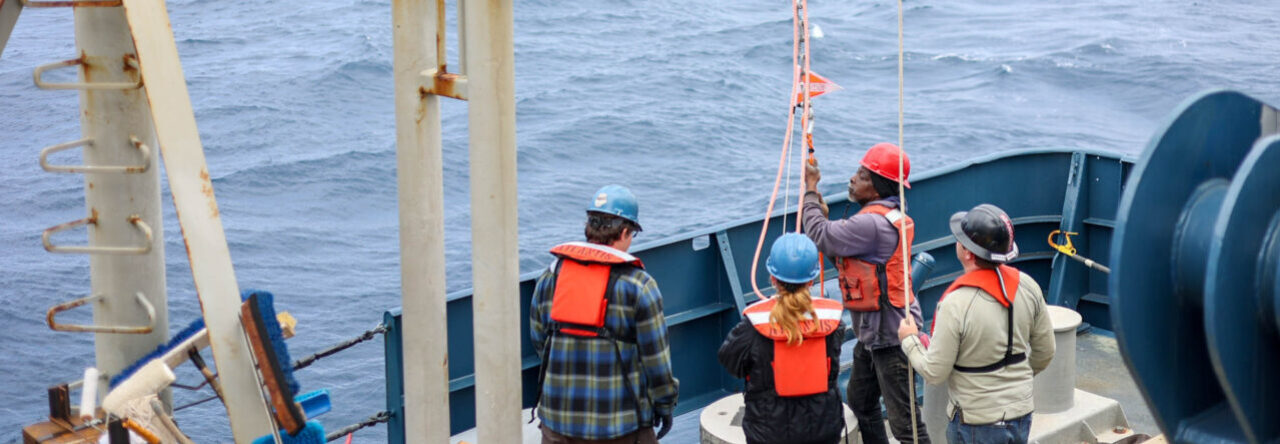Yesterday, July 26th, marked my first week aboard the R/V Pelican. The first cruise I am participating in during the course of this internship is conducting a shelf-wide hypoxia survey whose data will help continue a time-series data set that was started in 1985! For those who aren’t familiar with the word “hypoxia”, it means “low oxygen”. So, this science group is tracking zones of low oxygen along the continental shelf in the Northern Gulf of Mexico. The purpose of this time-series data set is to monitor the extent and severity of the summer hypoxic events that occur in this region. If you’d like to learn more about this project, you can do so through this website: https://gulfhypoxia.net/!
So far, 101 stations have been completed. All of these stations have occurred in locations West of the Mississippi River. As I write this, we are transiting to the stations and transect lines that are East of the Mississippi River. I have not been involved in all 101 stations, mind you. We are doing 24 hour operations, so myself, and two other Marine Technicians, Maggie and Susie, are working staggered shifts. I have been on shift for 52 of these stations.
At each of these stations, a CTD cast was completed, as well as the deployment of a Niskin bottle with a EOX3 Multiparameter Sonde Instrument attached.
A CTD cast is obtained using a CTD Rosette. On a CTD Rosette, a CTD instrument is housed in an instrument frame that also holds Niskin bottles. The CTD instrument collects the conductivity, temperature, and depth data of a water column. It can be outfitted with accessory instruments that measure other biological, chemical, and physical properties of the water. The Niskin bottles are used to collect water samples at certain depths within the water column. Niskin bottles can be manually or electronically closed to collect water at a certain depth in the water column being observed and measured. In the case of the Niskin bottles that are mounted on the CTD Rosette’s frame, they are electronically closed, or “fired”. This is done by hooking the elastic cords that are attached to the stoppers on both sides of the Niskin bottles to a central release mechanism. Each Niskin bottle has its own corresponding number that is identified in the computer program and, when “fired” the elastic cord is unhooked from the released mechanism and causes for the bottle to close, with the water inside.
During CTD casts, I have been involved with the physical deployment and recovery of the equipment (i.e., putting it into the water, and then taking it back out of the water, and getting the equipment back on the boat deck)., as well as the electronic/computer operations needed. I have enjoyed becoming more familiar with the SeaSave software, as well as becoming better able to troubleshoot issues faced during CTD cast operations.
Below is a series of pictures that will attempt to show what was described previously. From left to the right, the pictures are: The CTD Rosette, a close-up image of what the CTD instrument looks like (this specific model is the Seabird SBE 911Plus CTD), and the release mechanism for the Niskin bottles on the CTD Rosette.
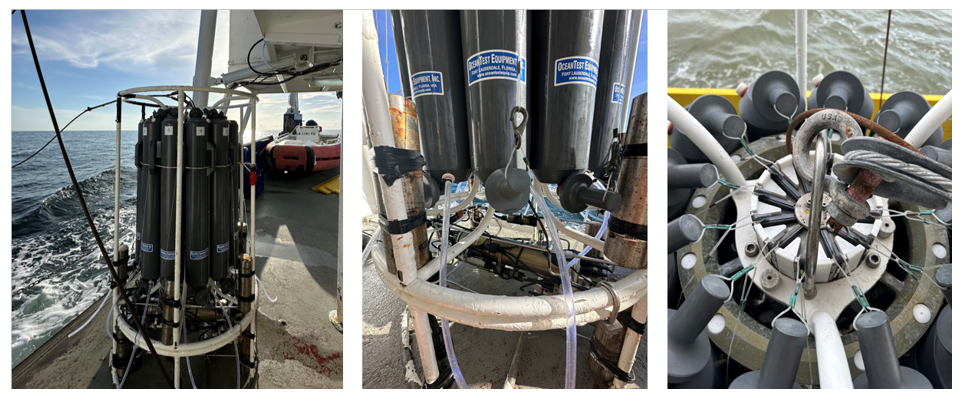
On the left is a picture of the CTD Rosette being deployed, and on the right is a picture of the data that was being collected by the CTD Rosette (this water profile was super cool, it was stratified!):
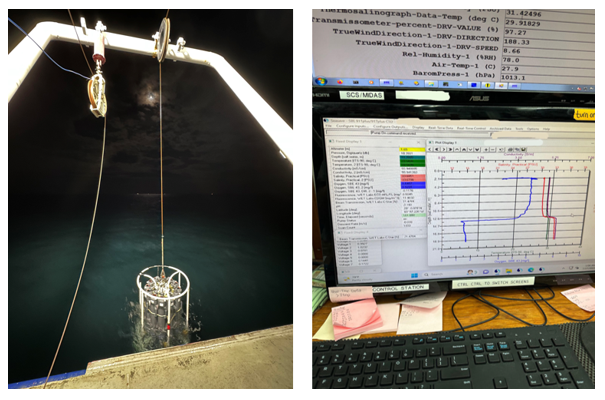
Like what was stated earlier, Niskin bottles can also be “fired” manually. This is done using a weight that is attached to the winch line (the line that connects the equipment in the water to a system, a winch, that can bring the equipment back on deck safely) and throwing it down the line so that the weight will trigger a release mechanism similar to the one seen on a Niskin bottle rosette set up. Again, I am glad that I have become more familiar with the deployment and recovery procedures associated with Niskin bottles.
The EOX3 Multiparameter Sonde is an instrument that the science crew brought with them, from my understanding, it’s like a small CTD. They are using this instrument to get oxygen concentration measurements closer to the seafloor than can be done with the CTD Rosette, also as a backup for the CTD Rosette if something were to happen.
Here is a picture of the Niskin bottle we have been using, I don’t have a picture of the EOX3 Multiparameter Sonde at the moment:
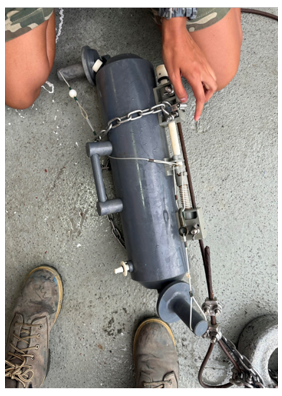
Also, at five of these stations, box core samples were also taken. A Box Corer is used to collect sediment samples (though, there are many methods and designs used to take sediment samples). This group will use the core samples to look at total and relative abundance of benthic infauna (organisms that live in the sediment on the ocean floor). Gaining experience with preparing the box core for deployment, deploying, recovering, and maintaining the equipment has been fun!
Here is a picture of myself and one of the other Marine Technicians on board, Susie, deploying the Box Corer:

Some other responsibilities I have while on shift include: monitoring the Flow Through system’s status, and turning off the water to the Flow Through when we get into really shallow water depths (< 5 m); making sure the ADCP (Acoustic Doppler Current Profiler, these instruments are able to determine current speed and direction within the water column) is working well; monitoring the Knudsen Chirp’s accuracy (the Knudsen Chirp is what we use to measure the water depth, it uses sound waves to do this); update transit times on the Navigation software; monitor the Science Computer System (SCS) (the SCS is where all of the background data constantly being collected is displayed and stored); and monitoring internet usage and connection. It has been interesting to learn more about computer networking!
In the next picture, you’ll see the monitors I use to monitor the computer network that displays the Flow Through, ADCP, Knudsen Chirp, SCS, Navigation software, and Wi-Fi network:
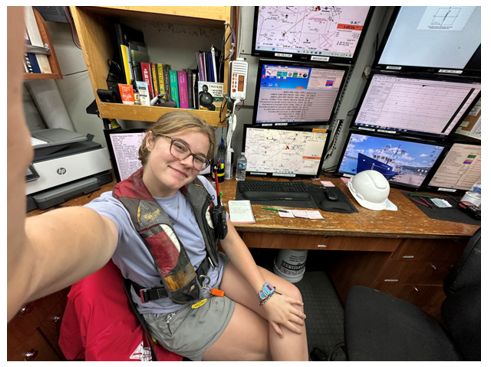
Besides the operations that I have been a part of during this cruise, I also helped with pre-cruise preparations and mobilization for this cruise. During my first morning aboard the R/V Pelican, I helped my mentor, Maggie, with preparing the flow through system, as well as the CTD with the correct instrument set up. I also learned how to add station points into the ship’s navigation program, and got to go out on the small boat that we have on board to learn how to run it! It was awesome to see a Louisiana bayou as I have never been here before!
Here is a picture of me adding a sensor to the CTD:
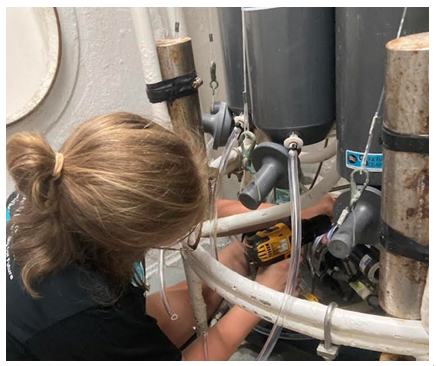
Here is a picture of me operating the small boat:
Of course, all of this has been related to the Marine Technician Intern role that I have been learning to fill. BUT, on transits and during my personal time on board, I have seen some cool stuff! Among the vibrant sunsets (when it hasn’t been overcast), there have been dolphins, and when we went into the Mississippi River, I got to see a phenomenon, where two water masses meet (in this case the Mississippi River and the Gulf of Mexico), but have not mixed yet!
Here are some pictures of what I just described seeing during transits and my off times:

Until next week!
Athena
(p.s., I am finding that communicating about what goes on during my day is quite difficult! There are a lot of moving parts and pieces (literally!), and a lot that goes on!)

